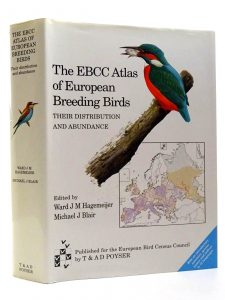EBCC Atlas of European Breeding Birds
 The first comprehensive EBCC Atlas of European Breeding Birds, or European Ornithological Atlas (EOA) edited by Ward Hagemeijer and Mike Blair, was published in 1997. The atlas is the first major initiative of the EBCC (itself created through the merging of the European Ornithological Atlas Committee and the IBCC) and integrates 25 years of effort by thousands of volunteer field ornithologists, data analysts, and writers in more than 40 countries. The final product is an impressive and voluminous book with more than 900 pages of maps of distribution for 495 European bird species, accompanying text and information on the population size estimates for key countries where it is present. The area covered includes all of Europe, including Madeira, the Azores, Iceland, Svalbard, Franz Josef Land, and Transcaucasia) although not Turkey or Cyprus. The atlas demonstrates what can be achieved through broadscale international cooperation and has been and remains an essential tool for scientists and conservationists interested in studying the patterns of distribution and abundance of Europe´s birds.
The first comprehensive EBCC Atlas of European Breeding Birds, or European Ornithological Atlas (EOA) edited by Ward Hagemeijer and Mike Blair, was published in 1997. The atlas is the first major initiative of the EBCC (itself created through the merging of the European Ornithological Atlas Committee and the IBCC) and integrates 25 years of effort by thousands of volunteer field ornithologists, data analysts, and writers in more than 40 countries. The final product is an impressive and voluminous book with more than 900 pages of maps of distribution for 495 European bird species, accompanying text and information on the population size estimates for key countries where it is present. The area covered includes all of Europe, including Madeira, the Azores, Iceland, Svalbard, Franz Josef Land, and Transcaucasia) although not Turkey or Cyprus. The atlas demonstrates what can be achieved through broadscale international cooperation and has been and remains an essential tool for scientists and conservationists interested in studying the patterns of distribution and abundance of Europe´s birds.
 EBCC Atlas on the Web:
EBCC Atlas on the Web:
easily accessible to a wide audience all distribution maps can now also be viewed through the internet. In this recent initiative, the original 50km x 50km basic spatial units in the atlas were converted to Geographic Information System (GIS) spatial references (e.g. latitude, longitude), in order to be able to display the species distribution maps on a website with different backgrounds as explained below. Because meridians of longitude converge towards the poles the original 50km by 50km grid required modifications to allow ‘squares’ to drop out as their width declined to less than 40km towards the north. Dealing with these issues in the conversion to GIS was no trivial task and the EBCC is very grateful to SOVON and especially Henk Sierdsema for all his time on this. As in the book, the dots on the map refer to six different categories of information; red = semi-quantitatively confirmed or probable breeding, orange = semi-quantitatively possible breeding, dark purple = qualitatively confirmed or probably breeding, light purple = qualitatively possible breeding, grey = no survey work, no dot = square surveyed but species not recorded. Semi-quantitative (red and orange dots) means that population sizes, in numbers of breeding pairs, for the square have been estimated to the nearest order of magnitude, as indicated by the size of the dots on the map. Not all countries were able to provide this and hence the information is qualitative (all purple and grey dots are the same size). The interactive distribution atlas is currently hosted by SOVON Dutch Centre for Field Ornithology and can be accessed through the link
Clicking on the link will display a new screen with selection options on the right-hand side.

In order to display a distribution map select the species, you are interested in, on one of the drop-down boxes, and click on the ‘show’ button.

The distribution can be displayed on satellite images of the earth (by clicking ‘Satellite’), or on maps provided by Google Earth (by clicking ‘Map’).

The display of country borders and display of the coverage of fieldwork (see legend for an explanation of the four different levels of coverage) can be turned on or off.

The size of the map can be enlarged by clicking on ‘hide’. This will hide the legend, allowing more room for displaying the map. It is also possible to use the pointer on the left of the map to zoom in or out and to move left, right, up or down, over the area of interest.

Go to the interactive EBCC Atlas of European Breeding Birds
The recommended citation for the atlas remains Hagemeijer, E.J.M., and M.J. Blair (editors). 1997. The EBCC Atlas of European Breeding Birds: their distribution and abundance. T & A.D. Poyser, London.
Obtaining the atlas data:
Associated with the atlas is the underlying database from which the distribution maps are derived. Over the past 10 years, the atlas data has been used by a wide variety of researchers and conservationists for purposes ranging from estimating hotspots of species occurrence to predicting the effects of climate change. The use of the data is administered via the EBCC Executive Committee and the data extraction and handling are currently done by staff at SOVON in the Netherlands or the BTO in the UK, according to agreed rules. There are countless possibilities for using this valuable dataset, and those interested should contact the EBCC Chair EBCC-chairman about the conditions for obtaining the data. Requests will be reviewed by the Executive Committee and there are usually costs for its provision and to cover data handling. EBCC Atlas of European Breeding Birds data is now available in UTM or GIS-format.